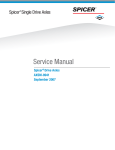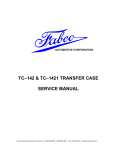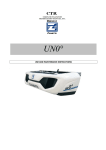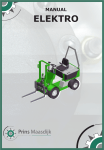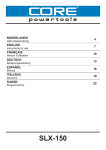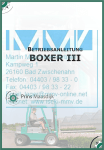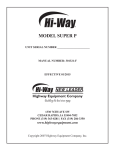Download User Manual Prins Boxer II
Transcript
User Manual BOXER II User Manual Boxer II INDEX Page 1. INTRODUCTION .......................................................................................... 3 2. SAFETY FIRST ............................................................................................. 4 3. GENERAL SAFETY REGULATIONS ..................................................................... 5 4. SUMMERY OF COMPONENTS .......................................................................... 7 5. OPERATING THE PRINS BOXER II ..................................................................... 8 5.1 How to start and stop the motor ..........................................................................8 5.2 Getting the forklift truck to move and stopping.....................................................10 5.3 Loading and unloading ......................................................................................12 6. SERVICE AND MAINTENANCE ....................................................................... 13 6.1 The transmission ..............................................................................................13 6.2 The Engine ......................................................................................................16 6.2.1 Engine.................................................................................................................16 6.2.2 Cooling system ...................................................................................................17 6.2.3 Fuel filter .............................................................................................................17 6.2.4 Air cleaner...........................................................................................................19 6.2.5 Battery ................................................................................................................20 6.2.6 Fan belt...............................................................................................................21 6.3 Hydraulic system ..............................................................................................22 6.4 Remaining maintenance .....................................................................................22 7. SCHEDULE SERVICE & MAINTENANCE ............................................................ 23 2 User Manual Boxer II 1. INTRODUCTION As manufacturer, we thank you for purchasing this Prins Boxer II Forklift truck. For your safety, please obey all safety guidelines as set out in this manual. To obtain a long and trouble free operation from your forklift keep up regular servicing and read this manual thoroughly before you start to work with it. Make sure other users of the truck read the manual as well. Keep this manual, after poring it over, on a place where you can find it easily back, so that you always have the information at one’s disposal concerning maintenance, defects and the like. When you want to order some parts, or you have questions/remarks about your forklift truck, please contact Prins Maasdijk. Please: always be sure you know your Service number and Serial number, mentioned on the tag plates in the right upper corner of the dashboard. Keep it always nearby when you call us. We wish you much success with your new forklift truck. Prins Maasdijk 3 User Manual Boxer II 2. SAFETY FIRST This user manual contains important facts about right and safe use of your forklift truck. Always follow the instructions that are mentioned in this manual. This symbol, the industry's "Safety Alert Symbol", is used throughout this manual and on labels on the machine itself to warn of the possibility of personal injury. Caution!: Important information Read these instructions carefully. It is essential that you read the instructions and safety regulations before you attempt to assemble or use this unit. 4 User Manual Boxer II 3. GENERAL SAFETY REGULATIONS Accidents can occur if the safety regulations are disregarded, insufficient care is taken during maintenance or when operating the machine. You must be aware of the risks entailed in certain actions. This manual describes potentially hazardous situations and the measures to be taken during operation and maintenance. It is impossible for the manufacturer to foresee every potentially hazardous situation, which may lead to injuries or damage. The user must ensure the safety of all actions, procedures or the use of any tools that are not recommended by the manufacturer. For your and other people’s safety: Never load the forklift truck above the maximum stipulated weight. Always check the loading diagram on the bonnet. The lifting capacity is halved when the load rests on only one fork. Avoid this as much as possible. Keep the load as close to the ground as possible when driving with a loaded machine. Never drive at top speed in this situation. Keep the forks approximately 10 to 20 cm above the ground. Keep the speed as low as possible when driving with an elevated load and keep track of the maximum clearance height. ALWAYS carry out the necessary preventive inspections and regular maintenance. Never start working with the machine unless it has been thoroughly checked. Pay particular attention to the tires, battery, brakes, steering gear, fuel system, and electrical components. Do not refuel while the engine is running. No smoking is allowed during refueling or changing / adding oil and fire and sparks must be prevented. Explosive gases are released during refueling. Carefully remove any spilt liquids after refueling or changing / adding oil. Before changing or adding oil, the machine must be checked for oil stains. Try to find out where they come from. If they are caused by a technical failure, first repair the failure before continuing working with the truck. When leaving the machine, ensure that the handbrake is engaged and that the gears are in neutral. A wrong sitting position can cause accidents. Always adjust the chair so that you can properly operate the levers and have a good sight. Never work with a truck without a safety guard or safety bracket (which are standard supply). 5 User Manual Boxer II Always wear you seat belts when operating the forklift truck. Operate at a speed that gives you positive control of the truck. High speeds can be very dangerous. Also sudden brakes, accelerations, or turns can cause dangerous situations. If you have to drive at locations with little clearance height, take the following things into account: o Always check if there is enough clearance above and beside the truck. o Keep all parts of the body inside the safety guard, keep your hands on the steering wheel and keep your feet on the pedals. o Pay attention to where you drive Gently operate the levers. This increases the life span of the truck and is much safer. Never walk under an elevated load. This is extremely dangerous. Never carry a person on the forks or on the truck. When lowering the forks, make sure the forks are horizontal or tilted a bit backwards. Never lower the forks when they are tilted forwards. The state of the machine can be checked by many factors. Any changes of sound, vibrations, or reactions on the levers can indicate failures. If you suspect a failure, immediately pull over the truck and stop the engine. Check for causes and take the necessary actions. Table 3.1 | Safety symbols Follow the instructions for use and safety Wear safety glasses and protective clothing Smoking and open flames prohibited Electrolyte is very corrosive Connectors are live, avoid contact Areas where batteries are stored or charged must be sufficiently ventilated Danger of explosions, avoid short circuits 6 User Manual Boxer II 4. SUMMERY OF COMPONENTS Figure 4.1 | Summary 1 2 3 4 5 6 7 8 9 10 11 – – – – – – – – – – – Mast Lift cylinder Back rest Tilt cylinder Fork carriage Forks Front wheel Back (steering) wheel Main counterweight Variable counterweight Safety guard 7 User Manual Boxer II 5. OPERATING THE PRINS BOXER II 5.1 How to start and stop the motor 1. Before starting the engine, the settle pedal must be completely depressed. Put the forward/backward switch in neutral, otherwise the engine will not start (see Figure 5.1) Figure 5.1 | Forward/backward switch 2. Turn the ignition key to the “ON” position and check if both the charge- and oil light on the dashboard will go on. Figure 5.2 | The ignition 3. If both lights are on, turn the key to “PREHEAT”. When the Preheat-light goes out, turn the key to “START”, after which the engine will start. Caution!: The preheat is set for about 6 seconds. When the outside temperature is very low, preheat for a longer period. Check Table 5.1 to see how much time should be added after the Preheat-light went out. Table 5.1 | Preheat times Temperature above 10°C between -5°C and 10°C under -5°C maximum interval for continuously pre-heating Extra Preheat time Not necessary About 5 seconds About 10 seconds 20 seconds 8 User Manual Boxer II 4. If the engine will not start in about 10 seconds, turn the ignition switch to the “OFF”position and wait for 30 seconds before trying to start again. Begin every try from step 1. Caution!: Never let the starter run for longer than 20 seconds. 5. When engine starts, check if oil pressure- and charge light are out. If not, stop the engine immediately and check the following possible causes. Oil pressure light stays on: o Check the oil level o Check for dust and other dirt in the engine oil o Check if there is a short circuit in the wiring Charge light stays on: o Check if the battery is charged o Check the level of battery acid o Check if there is a short circuit in the wiring If all these cases have been checked and no failure has been found, please contact your dealer. 6. In cold conditions, the engine may idle rough when first started. As the engine gets warmer, it will run regularly. Let the engine warm up by running it without load and at half throttle. 7. If you want to stop the engine, make sure the forward/backward switch is put in neutral. Also, lower the forks to the ground (this is to prevent accidents and to prevent that the lift cylinders will be loaded unnecessarily). Then turn the key to "OFF". Caution!: When leaving the machine, ensure that the handbrake is engaged and that the forward/backward switch is put in neutral. 9 User Manual Boxer II 5.2 Getting the forklift truck to move and stopping 1. To get the truck going, depress the settle pedal completely. 2. Put the forward/backward switch in the desired position. The “Boxer II” is equipped with an automatic transmission axle. Therefore, you can only choose between forward and reverse (see Figure 5.1). If you want to go forward, push the switch away from you until it cannot go further. To go backwards, pull the switch the same way towards you. Caution!: You should always check first to see if the handbrake is not engaged. 2 1 3 4 5 7 6 8 9 10 Figure 5.3 | Dashboard 10 1 – Handbrake 2 – Forward/backward switch 3 – Check lights 4 – Hour meter 5 – Fuel gauge 6 – Temperature gauge 7 – Lighting rear (option) 8 – Lighting front (option) 9 – Accumulator (option) 10 – Ignition switch User Manual Boxer II 1 – Clutch pedal 2 – Brake pedal 3 – Accelerator pedal 1 2 3 Figure 5.4 | Pedals 3. Next, release the clutch pedal while slowly depressing the accelerator pedal. The forklift truck will move in the desired direction. 4. To stop the truck, release the accelerator pedal and brake with the brake pedal. 5. Before the truck comes to a stop, depress the clutch pedal completely and brake until the truck has completely come to a stop. Caution!: When the clutch pedal is depressed, the brake gets partly activated. Be sure to use the brake pedal as well though to brake. 6. If the truck comes to a stop, put the forward/backward switch in neutral stand. If you are about to leave the truck, pull the handbrake tight. 11 User Manual Boxer II 5.3 Loading and unloading Caution!: Be sure, that the load is stacked properly. Falling load can cause harm for you and others. 1. Stop the truck in front of the load and lower the mast until it is vertical. 2. Move the fork to the correct height. 3. Drive forward until the load touches the backrest. Lift the load 5 to 10 cm. It is possible that the load is not standing completely at the edge of the trailer or the warehouse rack. In that case, insert the fork as far as possible inside and lift the load a bit. Caution!: When you lift the load, make sure that the load will not tilt forward. The forks must be inserted for two-thirds or three-quarters in the load (this depends on the weight of the load). 4. Slowly reverse until the load is positioned in a way that it can be fully taken on the forks. Slowly lower the load and insert the forks to its full length until it touches the backrest. Then lift the load 5 to 10 cm. Reverse far enough to be able to lower the load completely. 5. Lower the load to 10 or 20 cm above the ground. 6. Tilt the mast backwards completely. 7. Drive the load to the designated site. Caution!: Brake and steer extremely careful with load on the forks. Sudden changes of speed or direction can cause the load to fall. 8. Gradually slow down when you reach the storage site and stop. Then tilt the mast forwards until it is vertical. 9. Raise the load to 5 or 10 cm above the unloading point. Drive forwards slowly and lower the load onto the unloading site. 10. Reverse and pull out the fork two-thirds or three-quarters of the way. Lift the load 5 or 10 cm again. Position the load correctly above the unloading site. 11. Lower the load to the correct unloading position. 12. Pull out the fork completely and reverse slowly. 13. Return the mast to the vertical position. 12 User Manual Boxer II 6. SERVICE AND MAINTENANCE If you adhere to the instructions pertaining to regular lubrication and maintenance, you will encounter fewer problems and considerably increase your machine's life. Therefore, Prins Maasdijk recommends most strongly that you take the time to carry out the necessary service and maintenance every day, even when you may be tempted to ignore them once in a while. The time given in this manual is the time indicated by the service meter. However, machines that have to operate under difficult conditions must be inspected more often than stated in this manual. Caution!: Make sure that all maintenance as described in this manual will be done by an experienced person. By any doubt, please ask for a Prins Maasdijk mechanic. 6.1 The transmission After purchasing this forklift truck, the transmission needs 60 to 80 hours to warm up. During this time, the transmission must be regularly checked. Below, you will find the proceedings, which are necessary to keep your truck in a perfect condition and to prevent problems. On page 23 you will find a schedule of all proceedings of maintenance at the truck. During the warmed-up time (60-80 hours): 1. After each 10 hours of processing, check the oil level with the oil level stick (see L in Figure 6.1). If necessary, fill up the oil level (see A in Figure 6.1). Caution!: Only check the oil level if the engine is stationary and the oil is on temperature. 2. Check the transmission regularly on any oil leaking. After warmed-up time: 1. Remove the oil filter (see P in Figure 6.1) 2. Change transmission oil. First, drain the used oil by the outlet under the differential gear (see D in Figure 6.1) 3. Wash and dry-up the induction filter from the pump (see A in Figure 6.1) Periodical: After every 200 hours operating: 1. Check the oil level and if necessary refill After every 1000 hours operating: 1. Replace the oil from the transmission. First, drain the used oil by the outlet under the differential gear (see D in Figure 6.1) 13 User Manual Boxer II Caution!: If the running time is less than 1000 hours per year, then replace the oil each year. 2. Clean the oil filter by the feedhole. If there is any damage on the filter, it needs to be replaced. Never use a broken filter again! 3. Check the oil level from the differential gear (see F in Figure 6.1). If necessary, fill up (see F in Figure 6.1). Every 2000 hours operating: 1. Replace the oil from the differential. First, drain the used oil by the outlet under the differential gear (see D in Figure 6.1). Data for oil replacement Volume Transmission: Differential gear: 7,5 liter ± 3,0 liter Oil Transmission: Come under class ATF and corresponding with the specifications DEXRON IID or TYP “A” SUFFIX A of General Motors or C3 of Detroit Diesel Allison (e.g. MOBIL ATF 220 and FIAT TUTELA GI/A) or corresponding with the specifications MIL-L2104B and API CC (e.g. Mobil DELVAC 1110) or corresponding with the specifications MIL-L2104C and API CD (e.g. MOBIL DELVAC 1310) viscosity 10W20 Differential gear: Corresponding with the specifications MIL-L2105B or API GL5 viscosity SAE 90 or 80W90 Brake circuit: Brake liquid corresponding with the specifications SAE J 1703, FMVSS 116 DOT 3, CUNA DOT3 AB, FORD SAM 6C 9101A, ISO 4925. 14 User Manual Boxer II Figure 6.1 | The transmission A B C D E F G H L M N P R S T : Oil feedhole and distributor filter : Forward electro valve : Backward electro valve : Drain plug : Bleed plug : Oil feedhole transaxle : Inching control : Converter : Oil dipstick : Outlet oil cooler : Inlet oil cooler : 30μ filter (distributor filter) : Anti-shock valve : Temperature switch 115˚ ± 3˚ : Power diminisher 15 User Manual Boxer II 6.2 The Engine 6.2.1 Engine The engine of your new Prins forklift truck needs a warmed-up time as well. This will take about 50 hours. Below you find an overview of the actions, which are necessary to keep the engine of your forklift truck in optimal condition and to prevent problems. On page 23, you will find a table, which contains all actions that have to do with the maintenance of the forklift truck. During warmed-up time: 1. Regularly check the oil level in the oil sump of the engine with the oil dipstick. Fill, if necessary, oil up (also after warmed-up time). Caution!: Perform the check before you start the engine or at least 5 minutes after the engine is switched off. 2. Regularly check the engine for oil leaks. After warmed-up time: 1. Replace the oil filter Replacing the oil filter: o Remove the old oil filter using a filter wrench o Apply a film of oil on the gasket of the new oil filter o Tighten the filter by hand o After the filter has been placed, the oil level will drop a bit. First, check whether the filter does not leak. Then check the oil level and fill up the oil if necessary. Figure 6.2 | The oil filter 2. Change the oil. First, let the old oil flow away from the sump via the drain at the bottom of the engine. 16 User Manual Boxer II Periodical: Every 200 hours operating: 1. Replace the oil filter 2. Change the oil Data for oil changing Volume Oil sump: 5 liter Oil ELF Multiperformance 3C 15W40 or corresponding with the specifications MIL-L-2104C or API classification, CD level or higher 6.2.2 Cooling system It is important that the coolant level is at the usual level. Otherwise, the engine will be overheated, which can cause damage. Make it a rule to check the coolant level before every operation. The following actions have to be done. Caution!: Do not remove the radiator cap when the engine is hot. 1. Loosen the radiator cap slightly to the stop to relieve any excess pressure before removing the cap completely. 2. Remove the radiator pressure cap and check to see if the water reaches the supply port. 3. In the event of insufficient coolant, fill the radiator with cooling fluid. Never use muddy or seawater as coolant. 4. Be sure to tighten the radiator pressure cap securely after supplying cooling fluid. Coolant ELF COOLELF 6.2.3 Fuel filter Replace the filter element every six months or more if necessary. Air bleeding fuel system To prevent damage to the engine or engine parts, it can be required to bleed the fuel system. Caution!: Do not bleed a hot engine as this could cause fuel to spill onto a hot exhaust manifold, creating a danger of fire. It can even cause poisonous smoke to be released because of evaporating fuel. 17 User Manual Boxer II When is air bleeding of the fuel system required? o After the fuel filter and pipes have been detached and refitted o After the fuel tank has become empty o After long storage of the forklift truck The air bleeding procedure: 1. Fill the fuel tank to the fullest extent 2. Open the fuel filter faucet and loosen the air vent plug a few turns, until fuel comes out 3. Loosen the two bleeding screws on top of the fuel filter 4. Retighten the screws when fuel without bubbles comes out (see Figure 6.3) Figure 6.3 | The fuel filter Figure 6.4 | Fuel filter in engine block 18 User Manual Boxer II 6.2.4 Air cleaner The air cleaner makes sure the aspirated air for the engine is filtered. The element of the air cleaner fitted to this engine is a dry type, so never apply oil to it. Replace this filter element at least once a year. The air filter should be cleaned once a month. One can use compressed air, but avoid touching the element by the air pistol and blow from the inside to the outside. The pressure of compressed air must be under 7 bars. When replacing the element, take notice that the element has to be mounted carefully. Be sure that the element is tight up; otherwise, the element will oscillate and cause damage to the engine (see Figure 6.5 and Figure 6.6). Figure 6.5 | The air cleaner Figure 6.6 | Servicing the air cleaner 19 User Manual Boxer II 6.2.5 Battery The starter of the forklift truck among other things has required electrical energy. The energy is delivered by the battery, which for his part gets loaded by the dynamo, which is driven by the outgoing axle of the engine. There are several reasons the battery will not work properly. One of them is a bad connection of the wiring on the battery, which can be caused by oxidation. This is why the poles have to be greased with e.g. Vaseline. Another possible cause can be a low level of battery acid in the battery. In that case, the battery must be filled with distilled water. Do the following actions. Caution!: Be careful not to let the battery electrolyte contact your body or clothing, for the dilute sulfuric acid solution burns skin and eats holes in clothing. Should this happen, immediately wash it off with running water. 1. 2. 3. 4. Release the protection cap from the battery Disconnect the negative terminal Disconnect the positive one after that Loosen the filling plug and check the liquid level. If necessary, fill the battery up (see also Figure 6.7 and Figure 6.8) 5. When connecting the cables, start with the positive terminal and then connect the negative one. Cover the poles with Vaseline to protect them for oxidation Figure 6.7 | The battery Figure 6.8 | The level of battery acid 20 User Manual Boxer II 6.2.6 Fan belt The fan belt or V-belt takes care of the drive of the ventilator and the battery. An improperly adjusted fan belt can cause engine overheating and an insufficient battery discharging. This can be checked easily. Caution!: Be sure to stop the engine before checking belt tension. 1. Push with your finger in the middle of the fan belt, so it deflects. Deflection has to be 7-9 mm (0.28 to 0.35 inch).under load of 10 Kgf (22.1 Lbs.). Also, check belt for cracks and tears. 2. Loosen the two bolts holding the generator and adjust until proper tension is obtained. 3. Be sure to retighten the nuts and bolts after adjustment (see Figure 6.9). Figure 6.9 | Tighten the V-belt 21 User Manual Boxer II 6.3 Hydraulic system The tank should be 2/3 filled with hydraulic oil, measured with mast in down position. Hydraulic oil: ESSO H46 or OLNA H 46 Air bleeding hydraulic system Sometimes it is necessary to bleed the hydraulic system When is air bleeding of the hydraulic system required? o When lifting and steering is not in optimum condition The air bleeding procedure: 1. Loosen the oil pressure hose a few turns 2. Start the engine 3. Wait until oil is seen 4. Then tighten the oil pressure hose 6.4 Remaining maintenance Grease The following parts must be greased at least once a month: o Side-shift cylinder o Steering cylinder o Tilt axle o Tilt cylinders Tires The tire-pressure must be checked every week. The recommended tire-pressure is: o Front wheel : 2,5 bar o Back wheel : 3,0 bar 22 User Manual Boxer II 7. SCHEDULE SERVICE & MAINTENANCE Below, in Table 7.1 and Table 7.2 you find a list of actions that have to be done in order to keep your forklift truck in good condition. Table 7.1 | The Transmission Action Check oil level Check for oil leaking Replace distributor filter Change oil Clean induction filter Clean filter by feedhole Check oil level of differential gear Change differential oil Warmed-up time First 60-80 hours Every Every 200 1000 hours hours X regularly Every10 hours Before every use After 60-80 hours After 60-80 hours After 60-80 hours Every 2000 hours X Every year X X X X X Table 7.2 | The Engine Action Change oil Replace oil filter Clean air cleaner Replace air cleaner Check tension of fan belt Replace fan belt Check battery acid level Check coolant level Replace fuel filter Warmed-up time First 50 hours After 50 hours After 50 hours Before every use Every 100 hours X Every 200 hours Every 1000 hours Every 6 months X X X X X X X X 23
























